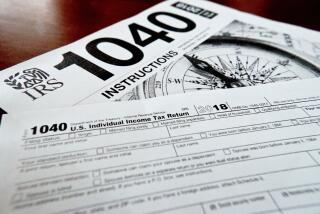IRS Loses Millions in Fraud With Electronic Tax Filing : Crime: Refunds are issued so quickly that the agency has no time to check facts and math, the GAO reports.
WASHINGTON — The Internal Revenue Service’s fast-growing system for allowing taxpayers to file their returns electronically has brought with it a wave of fraud that is costing the government millions of dollars, federal investigators reported Thursday.
Refunds for electronic returns are issued so quickly that the IRS cannot check all of them in time to catch cyberspace outlaws, the General Accounting Office told members of a House subcommittee.
Electronic filing has been a point of pride with the IRS, welcomed as a big stride along the government’s vaunted information highway. But it appears that electronic filing could become a highway rest stop that beckons crooks and thieves: False filing of returns by computer soared 105% last year, said the GAO, the investigative arm of Congress.
The IRS “has perfected the art of using its computers to give out tax refunds quickly without making a corresponding effort in the area of fraud controls,” said Rep. J. J. Pickle (D-Tex.), chairman of the House Ways and Means oversight subcommittee.
Thievery is relatively easy because the IRS often has as little as two days to investigate and stop a fraudulent refund after an electronic filing, compared with four to eight weeks for the traditional paper return. “The very thing that appeals to taxpayers--faster refunds--also increases IRS’ vulnerability to fraud,” the GAO reported.
Electronic filing, in which an individual’s tax return is transmitted by computer to the IRS, was first offered nationwide in 1990 and has grown rapidly. Last year, 12 million of the 115 million individual federal tax returns were filed electronically. The IRS’ ambitious game plan calls for collecting 80 million returns electronically by the year 2001.
The detection of fraudulent electronic filing rose to 25,633 returns during the first 10 months of last year, a 105% increase over the 12,488 bogus returns detected during the same period a year earlier. The false returns detected last year claimed refunds of $53 million, but the IRS was only able to stop $29 million before the refunds were issued.
And these figures could represent just the tip of the iceberg of criminality, GAO investigators said.
“Electronic filing fraud is a problem whose true dimensions are unknown,” said Jennie S. Stathis, GAO’s director of tax policy and administration issues, at a congressional hearing convened by Pickle’s oversight panel.
“The number of identified fraudulent electronic returns is relatively small, but the rate of growth is high and it is uncertain how much fraud might be going undetected,” she said.
A taxpayer who wants to file electronically must work through an individual or a company authorized by the IRS to file returns by computer. The taxpayer’s information is entered into the approved firm’s computer, then transmitted to the IRS computer network.
Some of the authorized firms can prepare and send the tax returns. Others act only as conduits, sending returns as submitted to them by taxpayers without checking their arithmetic or facts.
The IRS’ primary means of detecting bogus returns is to examine a sample group of returns after they have been filed. The agency discovered that as many as a third of the crooked electronic filers were people using false names and Social Security numbers on their returns.
IRS rules say that firms transmitting electronic returns must mail supporting paperwork--a document with the taxpayer’s signature along with W-2 forms and other income verification. These documents must be sent within a day after the return is filed.
Too often, however, the paper is not sent until after the refunds are issued, and sometimes it is never sent. IRS rules say firms that transmit tax returns electronically will be suspended for failing to send documents but the agency rarely enforces the rule, the GAO complained.
The GAO said in a December report to Congress that taxpayers who want to file electronically should be required to submit two pieces of identification, one with a photograph, to the firm doing the electronic filing. “The IRS has since decided not to require but only recommend that two forms of identification be required,” Stathis told the subcommittee.
IRS Commissioner Margaret Milner Richardson said her agency is vigilant in chasing false filers. With the current tax season only six weeks old, “we have already detected approximately 200 schemes involving approximately 3,000 attempts to file fraudulent claims on returns,” she said.
“We have already suspended several unscrupulous return preparers from the electronics system, initiated numerous criminal investigations and executed search warrants to obtain evidence,” she said.
More to Read
Inside the business of entertainment
The Wide Shot brings you news, analysis and insights on everything from streaming wars to production — and what it all means for the future.
You may occasionally receive promotional content from the Los Angeles Times.










